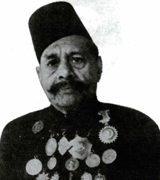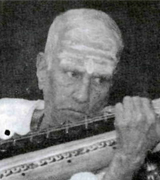Main Feature
Faiyyaz Khan

If any musician in living memory enjoys as fanatical a following as the football clubs of Calcutta, it is Ustad Faiyyaz Khan. His fans, though mostly above 70 now, will even come to blows to have him declared "Musician of the Century". Faiyyaz Khan was, without doubt, the most versatile, popular and influential musician all through the second quarter of the twentieth century. His was a formidable stature in an era endowed with giants in every gharana of khayal gayaki, and considered the Golden Age of Hindustani music.
He shot into prominence at the age of 20 with a brilliant performance at the Mysore Durbar. When he was 25, The Maharaja of Mysore made him asthana vidwan (court maestro), and conferred on him the title of Aftab-e-Mauseequi (the radiant sun of music), a prefix that stuck permanently to his name. At the age of 32, he was appointed to the Baroda Durbar. Over the next 30 years, he built up a towering national presence with Baroda as his base. He regaled three generations of audiences with dhrupad, dhamar, khayal, thumri, tappa, dadra, ghazal-s, and bhajan-s.
Tributes
K.P. Sivanandam

Music maestro and veena vidwan Tanjavur K.P. Sivanandam received the title of Sangeeta Kalanidhi, a title highly coveted by musicians, scholars and others associated with Carnatic music, from the Music Academy in Chennai after presiding over the annual conference of that institution in December 1992. He received the honour during the sadas or convocation on 1 January 1993.
In any given year, before the award is presented, there is usually much speculation and discussion about various persons either proposed for the honour or themselves seeking it. Sivanandam did not seek the honour; to do so would have done violence to the innate dignity and self-respect that have been the hallmark of not only his behaviour but also that of the distinguished artistic family to which he belongs. His father, K. Ponniah Pillai, a musician of distinction, had years earlier been honoured by the Music Academy with the Sangeeta Kalanidhi title, while his step brother K.P. Krishnamurthy, better known as Kittappa Pillai, had achieved great distinction in the field of Bharatanatyam after beginning his career as a musician. Furthermore, the family belonged to the lineage of the renowned brothers who collectively became known far and wide as the Tanjavur Quartet.
News & Notes
When Piyal Bhattacharya and Gautam Ghosal, both Kolkata-based dance lovers, braved great difficulties to reach Kerala and learn Kathakali and became eligible to add the name of Kalamandalam before their names, it was a great achievement for them as well as for dance lovers who revel in such cultural give and take. Piyal and Gautam, alongwith Jayashree Mundkur (arts activist and Mohini Attam teacher) recently launched Natyaloka, an organisation which organised a series of Kathakali programmes in Kolkata. With a troupe consisting mostly of artists from Kerala Kalamandalam and some from Santiniketan, they took the dance world by surprise by presenting some rarely performed dance-dramas to the people of the city. The team gave many performances from 10-13 April at Rabindra Bharati University, Jorasanko; Calcutta Kalamandalam campus at Golf Green; Padatik open-air theatre and Viswabharati, Santiniketan. At Sangeet Bhavan, Viswabharati they conducted a lecdem as well for a group of students. For their performances they chose the drama entitled Duryodhana Vadham, a portion from Narakasura Vadham, and Lavanasura Vadham.


